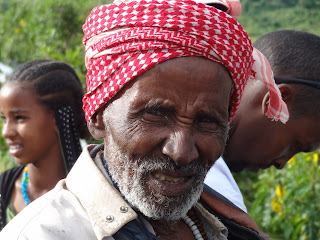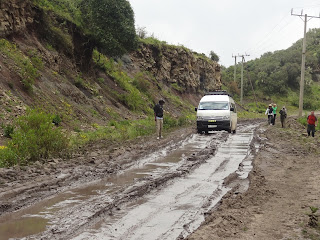First off, a surprising question I have gotten about this trip more than any other is "Why Ethiopia?" To be honest, that question saddens me a bit. Why not Ethiopia? Why shouldn't Ethiopia get there same kind of Wow or excitement? It is a beautiful and magical country and has so much to offer. Yes, I too had some misconceptions that have stayed in my brain from the 70's and 80's and the famine and those horrible pictures, but that was decades ago. Yes, tourism in Ethiopia really didn't start till a decade or two ago and although has a loooong way to go, all things considered, is doing a fine job. I was actually quite impressed with some amenities (most of the time!), including wi-fi!
Sooo... Hmmm... For once don't even know where to start. The history can be hundreds of blogs in itself, but I guess will begin with a short summary of our travels and as usual, include lot of pictures: Addis Ababa to Bahir Dar to Gondar to Simien Mountains to Lalibela (through Gondar again) to Mekele to Axum, pretty much reverse chronological order of the history of Ethiopia, so glad things came together at the end!
Addis Ababa (means "new flower" in Amharic, also 3rd highest capital in the world at 2400m or 7874ft):
This is probably more because I am more into nature and being out of cities that I purposely gave myself little to no time there. So needless to say, my short time there was ... Short and uneventful. What I can say, that is quite interesting, is that Ethiopia is one of the only countries is the world, besides Armenia but I didn't notice this when I went last year, that still actively uses the Julian calendar. What does that mean? Their years are 7 years behind the Gregorian calendar. So when I arrived there on Sept 12th and saw Happy New Year 2008, yes it did cross my mind that they were more behind the times than I thought, but lo and behold their New Year is on Sept 11th and they had all stayed up late and partied and festivities were still taking place on that New Years Day! Later I saw how they use both calendars, but really, on labels and even their passports, they have both dates. So yayyy, I can deduct 7 years off my age!!!
Nevertheless, although in and out of AA, managed to have the local St. George beer, the famous Ethiopian coffee AND their national dish, injera, more or less a flatbread sourdough that you can put various "toppings" on and eat with your hands (not in that order). I've had it before and it is a bit of an acquired taste, but I do have to say quite enjoyed it by the end of the trip!
Bahir Dar (took a flight there):
The capital of Amhara region and home of Lake Tana and the famous Blue Nile, which leads into the Nile River (we saw the junction). A big o hydroelectric power dam is being built on the Blue Nile, but fortunately because of the New Years celebration, we got to see a great waterfall (usually it closed or just a trickle of a water fall)!
The capital of Amhara region and home of Lake Tana and the famous Blue Nile, which leads into the Nile River (we saw the junction). A big o hydroelectric power dam is being built on the Blue Nile, but fortunately because of the New Years celebration, we got to see a great waterfall (usually it closed or just a trickle of a water fall)!
Hand-crafted wooden boat - I don't know how he stood on it, it had water on the inside and is really unstable!
Coffee beans!
Because people couldn't read, the bible is depicted as a story through paintings, quite remarkable that the colors (that came from flowers), is still so bright!
Above, our first coffee ceremony!
Having my first taste of Ethiopian honey wine - delicious! They put it in a small flask so that you have to drink slow as it is rather sweet and easy to drink too much too soon!
Each page of the bible is made of goat's skin, one goat, one page! The red text is for describing an important figure.
Drive from Bahir Dar to Gondar:
Traditional thatched roof houses that has been around for thousands of years. Fortunately, most homes now have tin on them to protect them from weather, however there are still poorer areas that can't afford the tin roofs.
Gondar - is a royal and ancient historical city of Ethiopia. It was the home of many emperors and princesses who led the country from the 12th century to the last decade of the 20th century. It is the home of the highest mountain in Ethiopia, Ras Dashen, and the Simien Mountains National Park. Also home to Fasiladas Castle and home of Emperor Fasilades Palace.
Above and below: Emperor Fasiladas Castle
Above: The walia flower! Also known as the New Year flower because it only comes out in September after the rainy season ends AND is the name of a local beer. They were beautiful!
Yay for G Adventures! Here is my super group of Colm, Mike, Maria, Thelma, Meg, Jill and guide Jeremiah (or Ermias)
Emperor Fasilades bath - a "holy" site during festivals and (once the "pool" is drained, cleaned and full again) thousands come here to celebrate Timkat, "Epiphany" for the Ethiopian Orthodox Church when they celebrate the baptism of Jesus.
Gondar market above and below
The boyz stopped to play some fooz ball, which surprisingly, we saw even in the most remote villages.
Above and below: Dobre Berhan Salassie Church, angles always "watching" you from the ceiling, no matter where you stand!
Back to school! We stopped by a local school for them to practice English (they were a bit shy). Then although they could flawlessly recite their national anthem, we all had struggles with ours. Oops!
The fun "shoulder" dance, which Ethiopia is known for, and especially Gondar, which has the best shoulder dancers in the country!
Drive to/from Simien Mountains from Gondar/Simien Mountains:
Shiro (chickpea stew) and injera (the bread) - famous local dish. On a side note, because of the Ethiopian Orthodox religion, they "fast" twice a week, Wednesdays and Fridays. The reason I say "fast" in "" is because they don't actually fast as we know it, their "fasting" means not eating before noon and then having only vegetarian food. Shiro is a great choice for that!
Our protector just in case there was an Ethiopian wolf (which by shear luck, Thelma in our group and Jeremiah saw one! There is supposed to be less than 50 in the whole park, BUT if you go down South, it is quite common to see them!).
We had quite a misty cool day, but these school children were probably the most polite we had seen. They raced to catch up to us, all carrying their little handcrafted goods, and then placed them on the ground, as you see, and then we would just pick one to buy and the kid would step forward. The kids were so anxious, you could almost see them yelling in their heads, "pick me! Pick me!" Very polite and well mannered, that's why we almost all bought something (versus them shoving things in our face)
The famous Gelado baboons, the most polite and calm baboon species I have ever seen! They did not even look up or move when we approached, when we stood there, and when we inched our way forward. They just ate the grace, grazed, and played along. There are also hundreds of them in the Simien mountains and it is quite mesmerizing to watch them play.
TIA - This Is Africa! No doubt there would be at least one time that we would get stuck!
I love this pic because really, this is how simply they farm. No new and modern technology, just ox like hundreds of years ago! Ethiopia is 80% farm, and many are completely dependent on it. That is why in the 70's and 80's when there was the drought, it created that devastating famine and over a million died. There was some politics involved in that, as I learned, but now they are better prepared with irrigation systems so hopefully it won't happen again (such a horrendous famine)
Ploughshare Women Crafts Training Centre in Falasha Village, a centre for giving handicraft skills to underprivileged single mothers. G Adventures supports them!
Kusquam, Queen Mentawab's 18th century residence and church, dedicated to St. Mary. Has skeletal remains of Empress Mentawab, Emperor Lyasu II, and her grandson, Lyoas, all found underground inside the church.
One of the best and most respected priest training schools, boys as young as 8 and 9 and up to late teens stay here for at least 7 years to study to become prists. It is extremely harsh living, 5-8 boys sleep in the little huts and they live an extremely simple and basic life with basic meals and learn the Bible inside out in Geez (the ancient language). The kids that graduate are known to be quite brilliant and then go on to serve as the well-respected guardians of churches.
And finally,
upon re-arrival to Gondar and last dinner before heading to Lalibela, beef BBQ meal! It was a bit burnt, but otherwise okay!
On that note.... Part 2 soon to come!





































































No comments:
Post a Comment